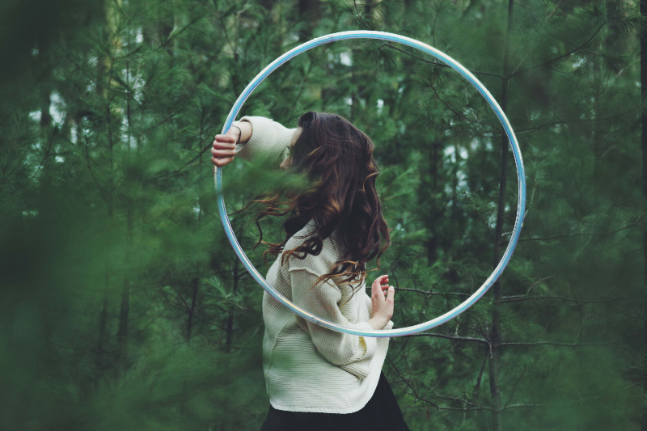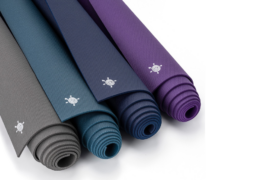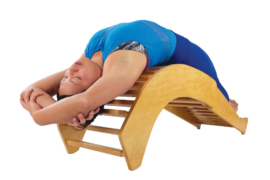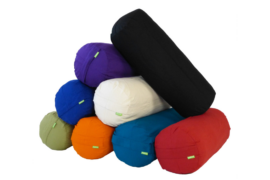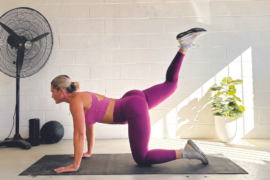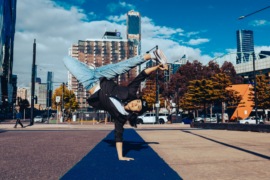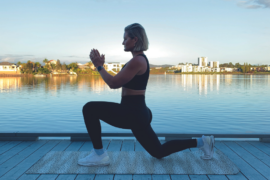The health benefits of hula hooping
Hula hooping has come a long way since the craze of the 1950s. Hoops may no longer dominate toy stores but they have branched out into circus tents, gyms, dance parties and even yoga studios. Considering the health benefits (and sheer fun) of hula hooping, it can be worthwhile picking up a hoop and exploring some of the ways you can enjoy modern hoop culture.
Hula health
It’s surprising just how many health benefits a simple hula hoop can bring. Hula hooping is well known for building core strength and burning calories — but it can do a lot more than that, particularly if you learn hand tricks as well as on-body moves. Physical benefits of hula hooping are that it:
- Tones the whole body
- Increases flexibility
- Has no-to-low impact
- Develops co-ordination
- Stimulates circulation
- Increases energy
- Improves balance
- Provides a cardio workout
- Improves posture
In addition to the above, hula hooping can strengthen your back and help loosen it up if you’ve been hunched over a computer all day. While hula hooping can relieve back pain, if you have an existing back problem please consult a doctor before taking up hula hooping as it can exacerbate certain conditions.
Hula hooping also offers emotional health benefits. It:
- Reduces stress
- Can have meditative effects due to the hypnotic rhythm
- Releases endorphins
- Develops self-confidence
How do you hoop?
Fitness classes
Considering the health benefits above, it’s not surprising that many gyms are beginning to incorporate hula hooping into fitness routines. Some gyms stock weighted — or occasionally regular— hoops so you can do a stint of waist hooping along with your usual exercises. If you’re lucky, you might even find a gym that offers hoop aerobics.
Hoop dancing
Modern hoop dance became popular in the late 1990s and early 2000s. While it could be simply classed as hooping to music, it usually involves a lot of on-body hoop moves with a few hand tricks thrown in. A hoop dancer will often shift the hoop up and down the body while dancing and may use multiple hoops — but it doesn’t need to be complicated to be fun. If you can keep the hoop going on your waist while moving your feet around a little, you’re dancing!
Circus hooping
If you’ve been to a circus in the last few years, chances are you’ve seen a hula hooper perform. They tend to string a number of dramatic tricks together that look very impressive. A common finale is to hoop with 20 or 30 hoops at once.
Hula hooping is well known for building core strength and burning calories — but it can do a lot more than that, particularly if you learn hand tricks as well as on-body moves.
While hula hoops may not be as popular in the schoolyard as they were 60 years ago, one way kids are currently getting into hoops is through circus workshops. There are plenty of circus workshops available for adults, too, usually including (or even focusing solely) on hula hooping.
There can be a considerable crossover between how a person hoops if they are dancing, doing a fitness routine or putting together a circus show, but the latter tends to involve a wide range of tricks. This style of hooping is often focused on performance, so moves that produce a “wow!” are taught — especially once you move on into intermediate and advanced classes.
Other ways to explore hula hooping
Hula hooping can be fused with a wide range of activities including tai chi, Pilates, burlesque and yoga. In yoga, for example, hula hooping can challenge and improve balance in certain postures. The frame of the hoop can also be used to extend stretches.
Another way to explore hoops is through rhythmic gymnastics. This is a combination of dance and gymnastics that incorporates the manipulation of objects such as balls, ribbons and hoops.
Choosing the right hoop
Now you have an idea of the different forms modern-day hooping can take, where do you start? Finding the right hoop can be a challenge as children’s hoops, sold in toy shops, are too small and flimsy for adults. For a good adult-sized hoop, try circus shops, local markets or the internet.
Some sports stores also stock hoops, usually the weighted variety. Hoop course teachers may also offer hoops for sale and this is a great opportunity to ask advice and experiment with different-sized hoops in class.
Before buying a hoop, it’s good to think about what kind of hooping you think you will be doing. If you just want to focus on toning your abdominals, a weighted hoop may be the right choice, but if you want to hoop dance or learn some circus tricks you will need a lighter hoop. Some people like to have two hoops: a slightly heavy, large hoop for waist hooping and a lighter, smaller hoop for hand tricks. However, a medium weight hoop (around 350 grams) can be a good compromise.
When you find a hoop trick that comes to you easily, keep coming back to it when you need to boost your confidence.
The general guide for finding the best-sized hoop for you is to stand a hoop on the ground in front of you and measure it against your body. You want it to reach to around your navel. While this is the guide, give the hoop a spin and see what works for you. If you are struggling to keep the hoop spinning on your waist, you may want a hoop that measures higher than your navel as each rotation will take a little longer, giving you a fraction longer to get your hips in position (it really does make a difference). If you do choose a slightly bigger hoop and want to perform off-body tricks, just make sure the hoop isn’t too cumbersome in your hands and won’t hit the ground if you spin it on either side of your body.
Special kinds of hoops
There are also a range of hoops that can make hooping all the more fun. Hoops not only come in a range of patterns and colours — they can also sparkle, reflect and glow in the dark.
Weighted hoops can be great for beginners as they tend to stay on the hips more easily than lighter hoops. While they aren’t very suitable for hoop dancing and hand tricks, if you just want to put on some music and hoop on your waist for 10 minutes or more it will do wonders for your core strength. Weighted hoops have a reputation for being the best type of hoop for building up core muscles but many hoopers argue that a lighter hoop works just as well as it require you to pump faster to keep it up. If you do decide to purchase a weighted hoop, please avoid the heavier types (over two kilograms) as they can cause bruising.
Collapsible hoops are perfect for travellers. There are two common types: one twists into smaller circles, the other pulls apart into several sections that be easily clicked back together when needed.
Grip hoops are best for on-body hooping, particularly for the slippery parts — such as thighs! There are a variety of tapes that will help the hoop adhere to your body. You can also buy hoop wax and rub it along the inner ring of your hoop.
Some people adopt hula hooping as a spiritual practice. Being a perfect circle, the hula hoop can be associated with the never-ending cycle of birth and rebirth.
Glow-in-the-dark hoops are covered in a tape that will glow for up to 12 hours after being charged for five minutes under an electric light or the sun. The advantage to these hoops is that they recharge for free. The only downside is that you need to take extra care of them. If you leave the hoops lying around in the sun too often, it will shorten their life span. A glow hoop that is well cared for will recharge for many years.
LED hoops are a brighter alternative to glow-tape hoops and come in a range of colours. Their only disadvantage lies in cost as they are more expensive to buy than glow-tape hoops and require batteries.
For the very experienced, there are also fire hoops! These usually have five or six spines with wicks that extend from the outside of the hoop. They look amazing but do come with risks so make sure you’re well versed in all the safety information before you attempt to use one.
Waist hooping
Waist hooping can be a good way to start exploring hoops. Some people just pick up a hoop and start waist hooping straight away, while others will need advice and several practice attempts. It can take a while to wire your brain for that particular movement. It also takes a lot of effort at first but, as you practise, your muscles strengthen and — eventually — waist hooping will become easy.
Try a few hand tricks, too. Some people struggle to get the knack of waist hooping but find hand tricks a breeze. When you find a hoop trick that comes to you easily, keep coming back to it when you need to boost your confidence.
To hoop on your waist, start with a straight posture, one foot in front of the other or feet side by side. You need to maintain this upright posture so try to resist tilting forward to see what you’re doing. The movement is quite simple: a back-and-forth movement in the direction of your feet.
Here are some troubleshooting tips:
- If the hoop slips down, put more energy in — you can’t miss a beat!
- Engage your core muscles.
- To save a hoop that is slipping, try going faster, spin in the same direction as the hoop or bend your knees to catch the hoop back on your waist.
- As you move, the hoop will hit two points on your waist. These are called power points. Try visualising these points and make sure they are both pushing against the hoop as it rotates. If your hoop starts to tilt, one power point is pushing more than the other.
- Think positively! Your body may need time to adapt. The more you practise the easier it will be.
Variations on waist hooping
- Try spinning the hoop in the other direction to keep your muscles balanced.
- Turn your body in a full circle the same direction the hoop is spinning. When you’ve got that, try turning the other way (you have to hoop faster).
- Experiment with your arms: move them around belly-dance style, place them on you head or cross your arms — whatever you can think of. If you move your arms around, it will increase your fitness.
- Practise speeding up and slowing down so you gain good control of the hoop.
- Move your feet around. If this is tricky at first, just try lifting one foot very slightly off the ground, then the other. Once you get used to that, lift them a little higher or shuffle them to one side. After a while you can try walking around or side stepping — another one that’s really good for fitness.
- When you have some hoop experience and have really good control, try kneeling and standing up while hooping.
Spiritual aspects of hooping
Some people adopt hula hooping as a spiritual practise. Being a perfect circle, the hula hoop can be associated with the never-ending cycle of birth and rebirth. Spinning can also be seen as mystical as it replicates the motion of the Earth.
If you’ve been hula hooping for a while and it no longer takes a serious effort to keep your hoop rotating, try relaxing and going with the flow of the hoop. Experienced hoop dancers might like to take the opportunity to let go and enter their “zone”, dancing fluidly and creatively.
If you’d like to use hooping as a meditation tool, here are some ideas:
- Try to find a quiet place to hoop where you won’t be distracted.
- Start by focusing on your breathing and try to keep this focus throughout your hoop session.
- Choose your music carefully or hoop in silence. You don’t want any music that will jar or distract you. I find music without lyrics works best.
- Start the session with some slow stretches and/or yoga exercises.
World Hoop Day
World Hoop Day occurs on the first Saturday in October every year. On the one hand, this is a fun day when people across the world gather together in big (or small) groups to jam with their hoops, thereby spreading general enthusiasm for a healthy activity. However, it’s also a day that focuses on fundraising. Donations gathered during World Hoop Day events enable hoop ambassadors to provide hula hoops to disadvantaged children around the world. They are distributed among places such as schools and orphanages. Find out more at worldhoopday.org.
Where to now?
As you can see, there are many ways to enjoy hula hoops — and they’re not just for kids. If you can buy or borrow a hoop, start playing around and see what you can do. Join a class, a workshop, a hoop jam or other hoop event — the hooping community in Australia is continuously expanding so look out for events near you.
Here are some useful websites to get you started:
